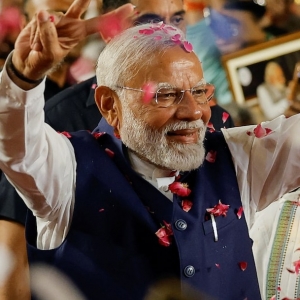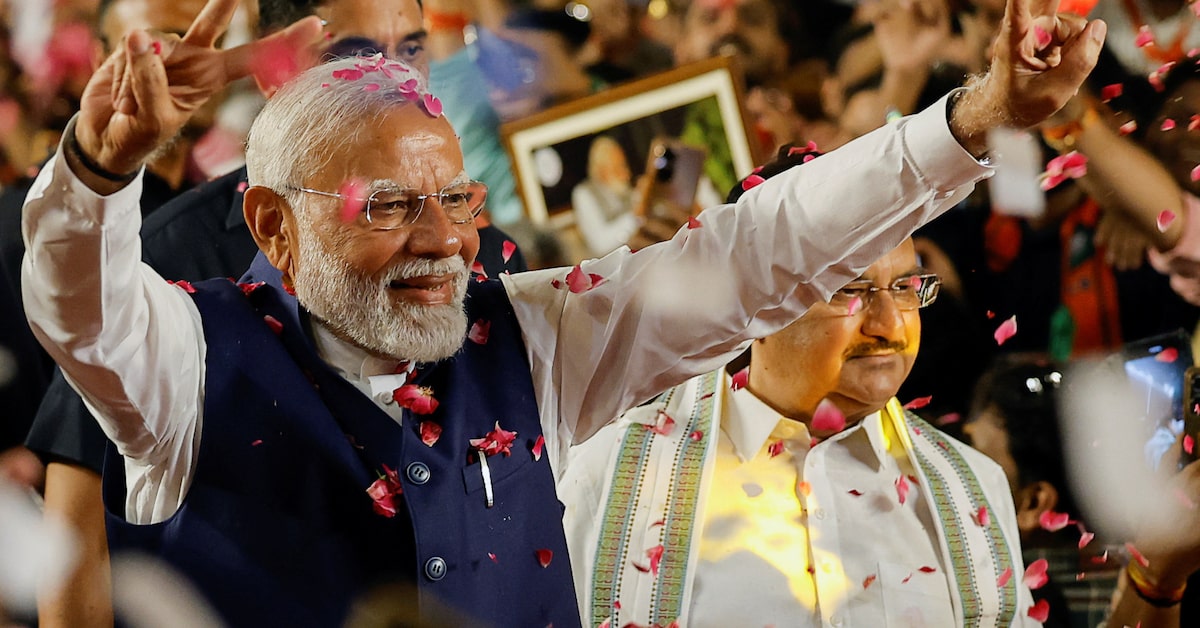
.png) John Dayal
John Dayal

It is not the Narendrabhai Damodardas Modi we have known through ten years of 24x7 media coverage - bulging chest, tall and colourful Rajput turbans, the best eyeglasses in the world, bespoke costumes, and patent shoes - who now takes oath for the third time as Prime Minister of India.
It will be a diminutive image of him at Rashtrapati Bhawan, cut to size in a blood-curdling general election in which he breathed death to all his enemies, political and demographic. In the end, he was spurned by the very Hindu vote he wooed so assiduously in India's heartland of Uttar Pradesh.
Hubris has demanded its toll from the man who said he thought he was possibly of divine birth, set on earth to live out his destiny as India's saviour.
He did indeed become prime minister three times in a row, just like the first prime minister, Jawaharlal Nehru, whose image he sullied for ten years through his speeches and his army of social media trolls.
But Nehru had won the first three general elections in newly independent India with generous margins and formed a government without needing external support. He, in fact, invited non-Congress statesmen to join his cabinet, among them Babasaheb Ambedkar.
Modi won the first two elections, albeit propelled by an Islamophobic campaign unparalleled in Indian history. His own winning margins were near historic, in sheer numbers if not in percentages. He used the NDA tag, though he did not have to, as the BJP had an overwhelming majority. But this time, his BJP fell short of a majority. He had to slink up to Andhra's new supremo, Telugu Desam's Nara Chandrababu Naidu, who swept to power in Andhra after twenty years, and to turncoat friend Nitish Kumar, chief minister of Bihar in a coalition government.
Modi's own vote in Varanasi shrunk by almost four lakhs, and the final humiliation was seeing his handpicked candidate lose in Ayodhya, where he had spent billions of rupees and energy building a temple to Lord Rama, which he installed personally as an unofficial head priest.
Personally humiliated and politically truncated, Modi's new government will be hobbled by his partners and more by an energised Opposition - led by a newly minted Rahul Gandhi, who will occupy the seat where his mother, Sonia Gandhi, sat since her husband Rajiv's death in 1989.
The new Modi will not run the government just with his henchman and home minister Amit Shah. Nor will he be able to use the Enforcement Directorate of the Finance Ministry, the Central Bureau of Investigation, the National Investigation Agency, the Intelligence Bureau and the Delhi Police, as he did to coerce political opponents, terrorise civil society, silence youth, trade unions and farmers, and otherwise erase any sign of dissidence, dissent or challenge.
Not that this is perfect freedom for these sections or for religious minorities. A wide swath of the country at its heart—Orissa, a new BJP state, Madhya Pradesh, Chhattisgarh, and Gujarat—is almost entirely saffron. The BJP in Madhya Pradesh has been in power for over 20 years straight. The police and government employees, teachers, and other staff in these states have been recruited for their political background and further trained in the Sangh doctrine. They will be a challenge. Political observers say it could have been different if not for a proverbial slip between the cup and the lip.
Mr Modi's National Democratic Alliance has 293 seats in the 543-member House; the Congress-led INDIA alliance won 232 seats. For the NDA, this is a terrible drop from the 352 seats it had in 2019. The final tally in the general election hardly tells the story across the country. The difference in vote shares between the NDA and INDIA was 1.62% of the votes cast. A slight switch and Modi would have been history. The NDA had 43.31% of the votes, INDIA 41.69%.
The speculation on the final numbers was encashed on the stock market by punters who bet on figures brandished by Exit Poll companies and the country's most prominent mainstream media corporations.
As analyst Manoj Kumar said, the expensive exit polls could not accurately capture discontent among the social and economic classes ranked low in India in key states, resulting in an overestimation of electoral support for the Prime Minister. The findings led to turmoil in Indian stock markets.
The jubilation on the news that the BJP was very far from the 400 target was nationwide. However, activists caution that the process of reversing the damage will be long and painful and would make demands not just on political parties but also institutions such as the Supreme Court of India and the massive bureaucracy, which has been working almost as if it were an adjunct of the ruling party.
Activist Harsh Mander, a prominent target of the regime, says the "election results of 2024 have not erased the dangers of fascism. The cadres of the Hindu Right remain powerful and motivated. The decade-long leadership of Narendra Modi had thrust India to the brink of an abyss. At stake in the 2024 contest was not just the fate of competing political parties and leaders."
The absolute victory of the magnitude he sought, many Indians feared, would have empowered Mr Modi to carry out the political dream of his parent, Rashtriya Swayamsevak Sangh. He would have scrapped the liberal democratic Indian Constitution and laid the foundations of a far-right Hindu Rashtra in which religious minorities are disenfranchised, and the Indigenous people have no rights over their natural resources.
Mr Modi was the only face in the election campaign with "Modi Ki Guarantee" as the party slogan. He faces no threat to his absolute control of the party. He will be 75 in a year, a retirement age he set for his seniors when he took control of the party and became prime minister in 2014. He sent packing his mentor and former deputy prime minister, Lal Kishan Advani, who launched the Hindutva campaign in 1990 and eventually got Mr Modi into the prime minister's house.
There is little doubt that Mr Modi was stopped in his tracks by a resurgent Indian National Congress, which welded a last-minute coalition of south Indian Dravidian parties such as the DMK that governs Tamil Nadu, west Indian Marathas of Maharashtra, and north Indian parties representing backward classes and Dalits. It was abbreviated to INDIA, associating it with the essence of the country.
At its head was the young Congress leader, Mr. Rahul Gandhi, son of the assassinated former premier Rajiv Gandhi, and scion of Jawaharlal Nehru-Indra Gandhi political heritage. His two-year campaign consisted of long marches across India in which he challenged Mr Modi in every village and town, calling out the prime minister's crony capitalists, his contempt of the Constitution and the rule of law, and his total disregard for civil liberties and human rights. India has the world's largest number of prisoners in its jails, a significant number of them Muslims and Dalits.
The campaign clicked and was assisted in no small measure by civil society endeavours and an army of social media influencers who used WhatsApp, YouTube, and other platforms to reach out in every nook and cranny where even Mr Modi's mainstream media could not be present. Mr Gandhi won the two seats he contested, one from Wayanad in Kerala and the other from the heartland Uttar Pradesh, where he had been defeated last time.
The Congress, which many commentators had given up as a living corpse, has seemingly revived itself in unlikely places, improving its national vote percentage. But so have the BJP in some southern states and regional parties such as the Samajwadi Party in Uttar Pradesh and the Telugu Desam in Andhra Pradesh.
Although Uttar Pradesh, the largest state in India, has seen the maximum persecution of Muslims and Christians under BJP rule, a reduction of the party's strength will not immediately help religious minorities and vulnerable sections. The BJP has absolute control over the central Indian states of Madhya Pradesh, Orissa and Chhattisgarh, which are home to a pretty large number of Christians, and Gujarat and Bihar, which have sizeable Muslim populations.
Mr Modi has also failed to make a dent in Bengal in the west and Karnataka and Tamil Nadu in the south. His allies in Maharashtra have been cut to size by a state collation of Mr Sharad Pawar's Nationalist Congress and the Hindu ethos Shiv Sena of former chief minister Uddhav Thackrey.
In Kerala, where the BJP tried to get a foothold for over half a century, the party has undoubtedly improved its vote tally. Its film actor candidate in Thrissur is neck-and-neck with candidates of the Communist Party Marxist and the Congress. If he does scrape through, there will be speculation that he was helped by elements of the various church groups in this traditional stronghold of the religion. Several prelates and others have assured support to the BJP. Mr Modi staged a coup when he enticed Anil Anthony, the son of former defence minister and senior Congress leader AK Anthony. Anthony lost from his constituency.
Mr Modi may not give up his dreams so easily. He had already taken several bold steps in the ten years of his rule, encouraging his acolytes, or Bhakts, to call him the Hindu Hriday Samrat, the Emperor of the Hearts of the Hindus. When he was not dressed in the attire and headdresses of the Indian feudal nobility or the armed forces, his favourite dress was of a "sadhu" or a devotee. His massive entourage of cameramen and reporters accompanied him as he meditated in a Himalayan cave, the Arabian Sea off the coast of his native Gujarat, and at Vivekananda Rock, the extreme tip of the Deccan plateau. In recent interviews, Mr Modi hinted that he believed he had a divine destiny and was possibly of heavenly birth. He was dead serious in the interview.
But his campaign was earthy. Rahul Gandhi and his mother, Mr Sonia Gandhi, were the primary targets. And Islamophobia was its chief arsenal. He targeted Muslims as vermin and infiltrators conspiring to rob Hindus of their resources, their women, and finally, their place as the majority community.
Clearly, over the last ten years, the biggest damage has been suffered by the Indian National Congress party, which crashed from 206 seats in the 2009 elections to 44 seats in 2014 and 52 seats in the 2019 elections. On the other hand, the biggest winner has been the BJP, which went from 116 seats in the 2009 elections to 282 in 2014 and 303 seats in the 2019 elections.
International columnist Javed Naqvi noted that the BJP has successfully dismantled many state governments led by opposition parties over the last ten years. Often, the BJP enticed opposition Members of the Legislative Assembly (MLAs) to resign from the opposition and join their ranks. Once the governments were dismantled, the BJP would use the new MLAs to form its own government. Examples of this practice can be seen in Goa in 2019 and 2022, Karnataka in 2019, Madhya Pradesh in 2020, Maharashtra in 2022 and most recently in Himachal Pradesh in 2024. Whether Mr Modi can now break any opposition groups is now moot.